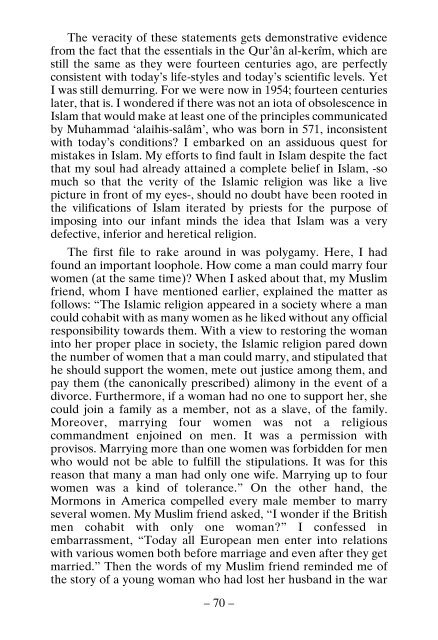Why Did They Become Muslims
WHY DID THEY BECOME MUSLIMS? The book Why Did They Become Muslims consists of 3 sections. Section I is a book of Islam and Christianity. Information about Prophets, books, religions (Judaism, Christianity and Islam) is given, conditions of being a true Muslim are explained, the words of those filled with admiration for Islam and the lives of 42 people who being a member of other religions chose Islam are narrated. Section II is a book of the Qur’an-ı Karîm and the Torah and the Bibles as of Today. Information about today’s Torah and Bibles is given, errors in the Bible are explained; that the Qur’an-ı Karîm is the last and unchangeable book is explained scientifically. Besides, explained are miracles, virtues, moral practices and habits of Muhammad ´alayhissalâm. Section III is a book of Islam and Other Religions. That Islam is not a religion of savageness, that a true Muslim is not ignorant, that there can be no philosophy in Islam are explained along with explanations of primitive religions and celestial religions.
WHY DID THEY BECOME MUSLIMS?
The book Why Did They Become Muslims consists of 3 sections. Section I is a book of Islam and Christianity. Information about Prophets, books, religions (Judaism, Christianity and Islam) is given, conditions of being a true Muslim are explained, the words of those filled with admiration for Islam and the lives of 42 people who being a member of other religions chose Islam are narrated. Section II is a book of the Qur’an-ı Karîm and the Torah and the Bibles as of Today. Information about today’s Torah and Bibles is given, errors in the Bible are explained; that the Qur’an-ı Karîm is the last and unchangeable book is explained scientifically. Besides, explained are miracles, virtues, moral practices and habits of Muhammad ´alayhissalâm. Section III is a book of Islam and Other Religions. That Islam is not a religion of savageness, that a true Muslim is not ignorant, that there can be no philosophy in Islam are explained along with explanations of primitive religions and celestial religions.
Create successful ePaper yourself
Turn your PDF publications into a flip-book with our unique Google optimized e-Paper software.
The veracity of these statements gets demonstrative evidence<br />
from the fact that the essentials in the Qur’ân al-kerîm, which are<br />
still the same as they were fourteen centuries ago, are perfectly<br />
consistent with today’s life-styles and today’s scientific levels. Yet<br />
I was still demurring. For we were now in 1954; fourteen centuries<br />
later, that is. I wondered if there was not an iota of obsolescence in<br />
Islam that would make at least one of the principles communicated<br />
by Muhammad ‘alaihis-salâm’, who was born in 571, inconsistent<br />
with today’s conditions? I embarked on an assiduous quest for<br />
mistakes in Islam. My efforts to find fault in Islam despite the fact<br />
that my soul had already attained a complete belief in Islam, -so<br />
much so that the verity of the Islamic religion was like a live<br />
picture in front of my eyes-, should no doubt have been rooted in<br />
the vilifications of Islam iterated by priests for the purpose of<br />
imposing into our infant minds the idea that Islam was a very<br />
defective, inferior and heretical religion.<br />
The first file to rake around in was polygamy. Here, I had<br />
found an important loophole. How come a man could marry four<br />
women (at the same time)? When I asked about that, my Muslim<br />
friend, whom I have mentioned earlier, explained the matter as<br />
follows: “The Islamic religion appeared in a society where a man<br />
could cohabit with as many women as he liked without any official<br />
responsibility towards them. With a view to restoring the woman<br />
into her proper place in society, the Islamic religion pared down<br />
the number of women that a man could marry, and stipulated that<br />
he should support the women, mete out justice among them, and<br />
pay them (the canonically prescribed) alimony in the event of a<br />
divorce. Furthermore, if a woman had no one to support her, she<br />
could join a family as a member, not as a slave, of the family.<br />
Moreover, marrying four women was not a religious<br />
commandment enjoined on men. It was a permission with<br />
provisos. Marrying more than one women was forbidden for men<br />
who would not be able to fulfill the stipulations. It was for this<br />
reason that many a man had only one wife. Marrying up to four<br />
women was a kind of tolerance.” On the other hand, the<br />
Mormons in America compelled every male member to marry<br />
several women. My Muslim friend asked, “I wonder if the British<br />
men cohabit with only one woman?” I confessed in<br />
embarrassment, “Today all European men enter into relations<br />
with various women both before marriage and even after they get<br />
married.” Then the words of my Muslim friend reminded me of<br />
the story of a young woman who had lost her husband in the war<br />
– 70 –

















